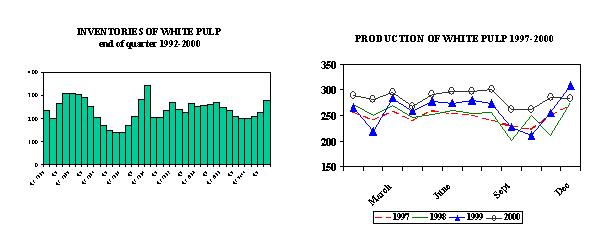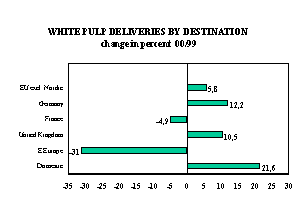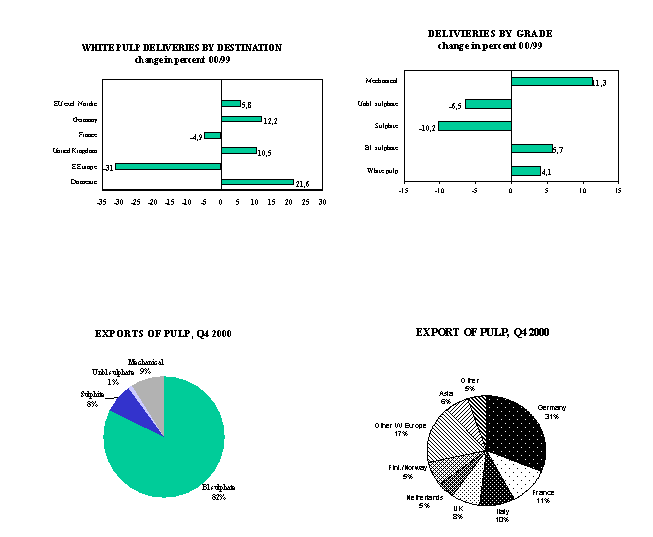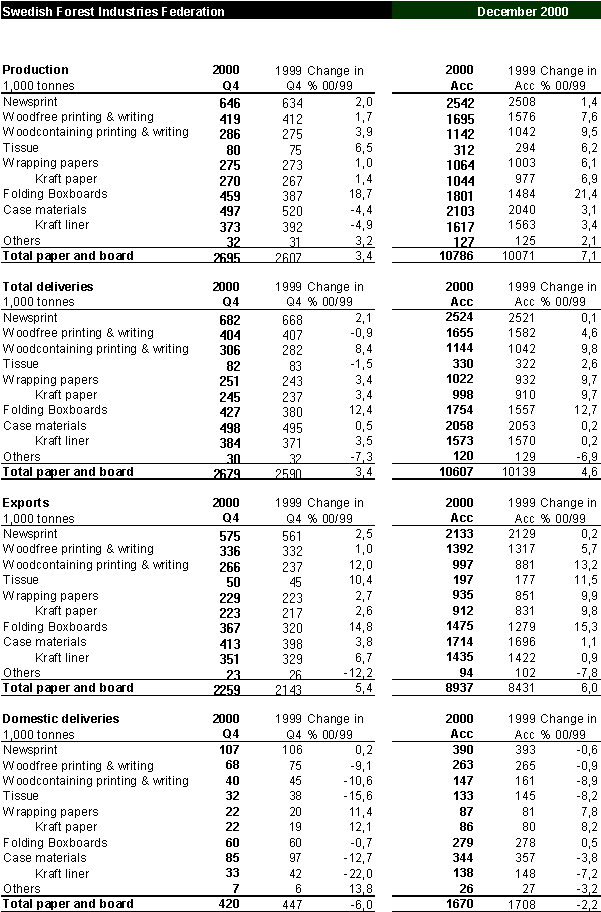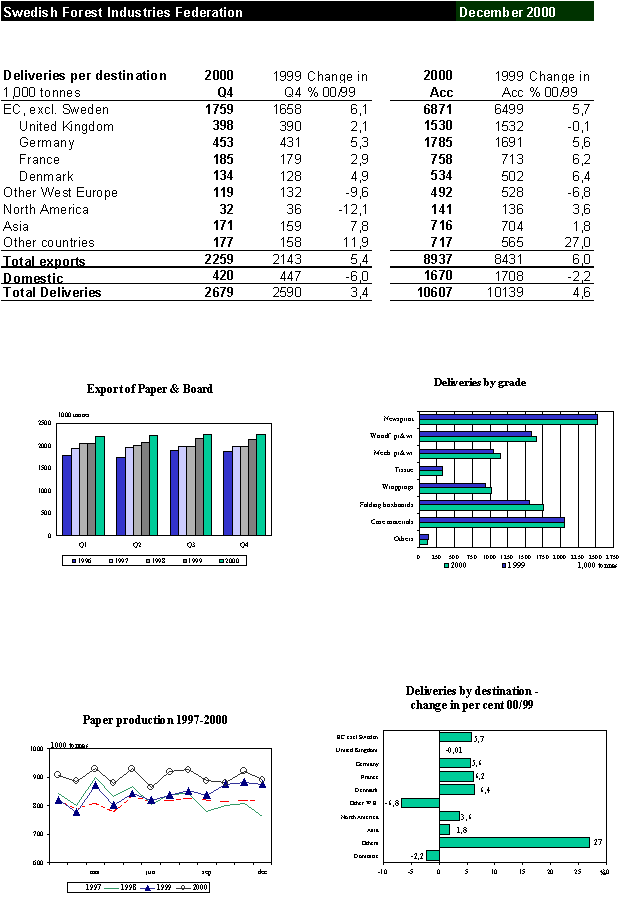


Swedish Forest Industries Association
The Swedish economy slowed down towards the end of 2000, following the global economic weakening. For the year, strong global demand resulted in exports increasing by close to 10 percent. In addition, private consumption maintained strong growth, whereas investments slowed somewhat compared to the previous year. The Riksbank raised its repo rate to curb inflationary pressure. The trade balance showed a considerable surplus. GDP growth in 2000 reached 3.8 percent.
Key indicators, percentage change:
1999 |
2000 preliminary | |
GDP |
4.1 |
3.8 |
Consumer prices |
1.2 |
1.3 |
Open unemployment* |
5.6 |
4.7 |
Exports |
2.9 |
9.8 |
Private consumption |
3.8 |
3.8 |
* as percentage of labour force
For pulp and paper production and deliveries, please see the tables that follow.
The recovered paper collection rate was 63 percent.
The production of sawn timber increased by 2 percent to 14.9 million m3. Deliveries remained more or less at the 1999 level.
Exports of forest industry product increased by 13 percent to SKr105 billion in 2000 compared to 1999.
Investments in the pulp and paper industry in Sweden reached SKr5 billion in 2000 and are predicted to reach SKr7 billion this year. Major investment plans are a coating machine for fine paper, and a new machine for producing magazine paper, replacing an old paper machine. Investments in the sawmilling industry amounted to SKr1.7 billion in 2000, and the same amount is forecast for this year.
According to the most recent capacity survey, paper and board capacity will increase by 70 000 tonnes to 11.18 million tonnes in 2001. Market pulp capacity will increase by 150 000 tonnes in 2001.
A governmental committee presented in April 2000 a proposed climate strategy comprising objectives and an action programme for achieving them. The action programme includes measures, policy instruments and planning as well as organizational proposals for implementation. Another governmental committee has had the task to examine the feasibility and conditions for applying the flexible mechanisms of the Kyoto Protocol in Sweden. A Governmental Bill is expected to follow in September.
The studies mentioned above declare openness to sinks as part of future solutions. It is the industry's view that sinks have to be taken into account.
The Forest Stewardship Council (FSC) standard is by all companies combined with environmental management systems, such as ISO 14001 or EMAS.
New rules for labelling have been decided by the Board of FSC. The rules will make it easier for the companies to use the FSC mark and increased volumes are foreseen for FSC labelled products in the future.
The production of white pulp for 2000 amounted to 3.4 million tonnes, up about 300 000 tonnes or 9 percent compared to 1999.
The capacity utilization of white pulp was 97 percent.
Mechanical pulp production rose by 10 percent to 392 000 tonnes.
Exports of mechanical pulp increased by 11 percent or about 30 000 tonnes, to 266 000 tonnes, while exports of white pulp increased by 1 percent to 2.7 million tonnes.
Deliveries of white pulp to the major markets Germany and the United Kingdom rose by 12 and 10 percent, respectively, while exports to France and Italy fell by 5 and 7 percent, respectively.
Deliveries to Asia continued to decline and amounted 115 000 tonnes. The decrease was 42 000 tonnes or 39 percent.
At the end of December, producers' inventories of white pulp were 276 000 tonnes, up 78 000 tonnes on end 1999.
The paper and board production in 2000 reached a record level of 10.8 million tonnes, up 715 000 tonnes or 7 percent compared with last year's figure.
Capacity utilization was 97 percent, compared to 92 percent for 1999.
Production of folding boxboard increased by 21 percent or 316 000 tonnes, to 1.8 million tonnes, resulting from a recovery of a 1999 decline and increased capacity utilization.
For fourth quarter, the paper and board production was 2.7 million tonnes, up 3 percent.
Exports for 2000 were 8.9 million tonnes, an increase of 6 percent compared with 1999.
Domestic deliveries declined by 2 percent to 1.7 million tonnes.
Exports of woodfree printing and writing paper continued to rise during the year to 1.7 million tonnes, 5 percent up on last year also exports of wood-containing printing and writing paper rose by 10 percent during 2000.
Exports of wrapping papers and folding boxboards were up 10 and 13 percent, respectively, compared to the previous year.
Deliveries to the major markets Germany and France rose by 6 percent while exports to the United Kingdom were unchanged.
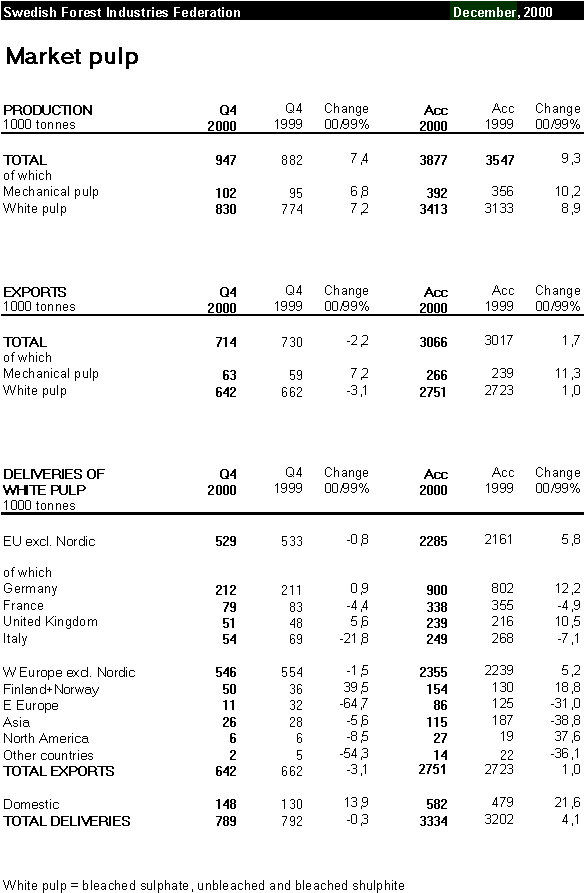
![]()
